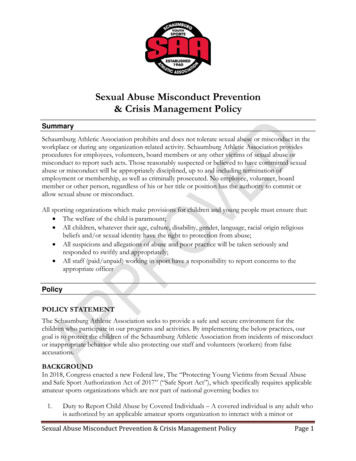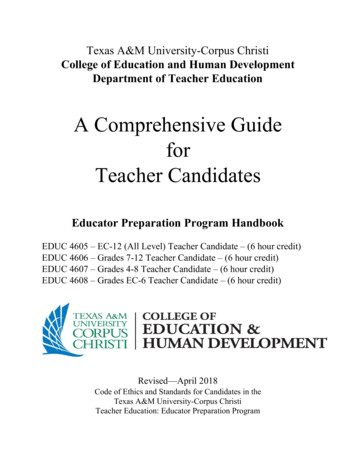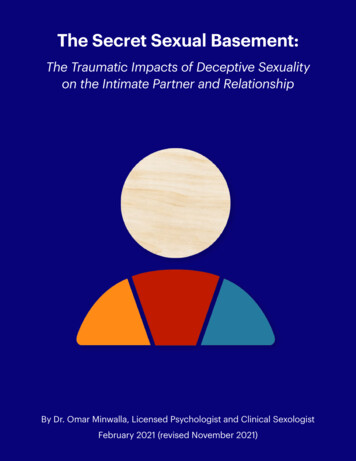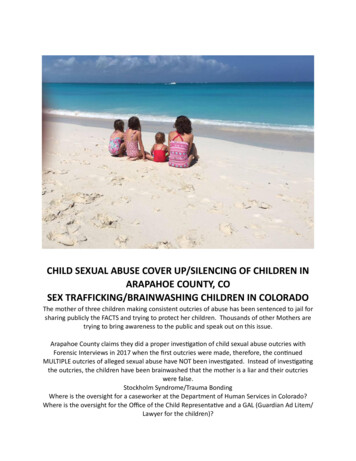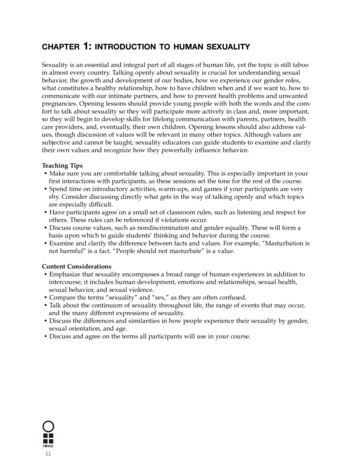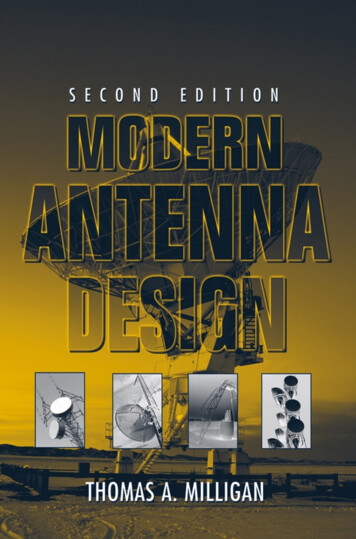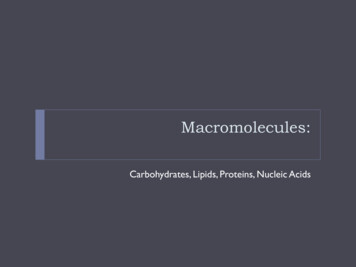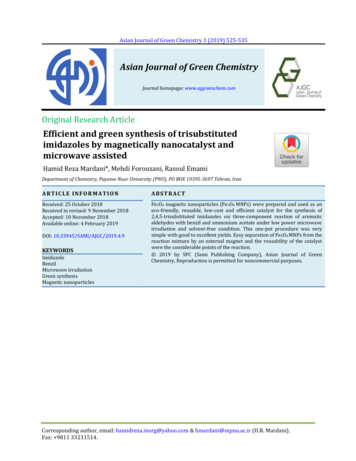
Transcription
POLICY AND PROGRAM STUDIES SERVICEEducator Sexual Misconduct:A Synthesis of Existing Literature2004U.S. DEPARTMENT OF EDUCATIONDOC # 2004-09OFFICE OF THE UNDER SECRETARY
Educator Sexual Misconduct:A Synthesis of Existing LiteraturePrepared for the U.S. Department of EducationOffice of the Under SecretaryPolicy and Program Studies ServiceBy Charol ShakeshaftHofstra University and Interactive, Inc.Huntington, N.Y.2
This report was prepared for the U.S. Department of Education under Purchase OrderED-02-PO-3281. The views expressed herein are those of the authors. No officialendorsement by the U.S. Department of Education is intended or should be inferred.U.S. Department of EducationRod PaigeSecretaryJune 2004This report is in the public domain. Authorization to reproduce it in whole or in part isgranted. While permission to reprint this publication is not necessary, the citation shouldbe: U.S. Department of Education, Office of the Under Secretary, Educator SexualMisconduct: A Synthesis of Existing Literature, Washington, D.C., 2004.
CONTENTS1.0 Purpose and Methods of Synthesis1.1 Definitions1.2 Scope of synthesis search1.3 Methods of synthesis12.0 Description of Existing Research, Literature, or Other Verifiable Sources2.1 Categories of discourse2.2 Systematic studies2.3 Practice-based accounts with first or third person descriptions2.4 Newspaper and other media sources2.5 General child sexual abuse data sets and instruments2.6 Availability of research43.0 Prevalence of Educator Sexual Misconduct3.1 Sources and methods3.2 Prevalence in the United States3.3 Prevalence in the United Kingdom164.0 Offender Characteristics4.1 Job of offenders4.2 Sex of offenders4.3 Age of offenders4.4 Same-sex offenders225.0 Targets of Educator Sexual Misconduct5.1 Sex of targets5.2 Race/ethnicity of target5.3 Disability and targets276.0 Patterns of Educator Sexual Misconduct with Students6.1 Context6.2 Selection6.3 Maintaining secrecy and silence6.4 Geography of abuse317.0 Allegations and Response7.1 Allegations7.2 Response to allegations7.3 Investigative practices7.4 False accusations348.0 Extent and Impact of Legal Initiative8.1 Federal laws8.2 State child sexual abuse laws372
8.3 State sexual assault laws8.4 State educator sexual misconduct laws8.5 Limitations of state laws8.6 Tenure and licensure8.7 Fingerprinting9.0 Effects of Educator Sexual Misconduct9.1 Effects on abused students: Academic, emotional anddevelopmental9.2 Effects on other students4210.0 Consequences of Allegations of Educator Sexual Misconduct10.1 Consequences for abusers10.2 Consequences for targets4411.0 Union and Professional Organization Roles11.1 Actions of teacher unions11.2 Actions of professional organizations4612.0 Prevention of Educator Sexual Misconduct12.1 Develop district and school level policies12.2 Hiring practices12.3 Screen employees12.4 Assign a case coordinator and centralize information12.5 Report all allegations to both child protection and law enforcementagencies12.6 Develop thorough investigative practices12.7 Educate employees12.8 Educate students12.9 Be aware of signs of educator sexual misconduct12.10 Change state educator certification regulations12.11 Provide adequate state registry12.12 Provide adequate federal registry12.13 Enact and standardize state policies and statutes12.14 Enact laws giving immunity to public employees who providereferences12.15 Expand Title IX4713.0 Summary of Existing Studies and Recommendations forAdditional Analysis51Appendix I Newspaper, News Wire, and Broadcast ReferencesAppendix II Surveys and Studies on Child Sexual AbuseBibliography: Educator Sexual Misconduct5381893
TABLESTable 1. Empirical Studies of Educator Sexual MisconductTable 2. Summary of Practice-Based, First Person Reports andThird Person ReportsTable 3. Empirical and Practice Studies of Educator Sexual MisconductTable 4. Studies of Prevalence of Educator Sexual Misconduct in theUnited StatesTable 5. Percent of U.S. Students Who Have Experienced EducatorSexual Misconduct by MethodTable 6. Sources for Descriptions of OffendersTable 7. Percent of Student Targets by Job Title of OffenderTable 8. Sex of OffendersTable 9. Same-Sex MisconductTable 10. U.S. Sources for Descriptions of TargetsTable 11. Targets by SexTable 12. Targets by Race/Ethnicity vs. SampleTable 13. Targets by Race/Ethnicity and Sex vs. SampleTable 14. Sexual Abuse Reports by Disability Status, in Institutional SettingsTable 15. Sources for Descriptions of PatternsTable 16. Sources for Allegations and ResponseTable 17. Suggestions and Recommendations from the Literature for PossibleLegislation and RegulationTable 18. Effects of Educator Sexual MisconductTable 19. Educator Sexual Misconduct: Data Available and NeedsFor Future Research4691316202324252627282829303134394251
PrefaceAny adult misconduct or sexual abuse in schools is of grave concern to students, parents,educators, and the Department of Education. This literature review of sexual abuse and sexualmisconduct responds to the mandate in Section 5414 of the Elementary and Secondary EducationAct of 1965 (ESEA), as amended, to conduct a study of sexual abuse in U.S. schools. To satisfythis mandate, the Department of Education contracted with Dr. Charol Shakeshaft of HofstraUniversity. Using the limited research that is available in this area, her literature reviewdescribes, among other topics: prevalence of educator sexual misconduct, offender characteristics,targets of educator sexual misconduct, and recommendations for prevention of educator sexualmisconduct. We note that the author offers several new recommendations that may be worthconsidering, although some may be at odds with current law.Although the author’s findings are in part broader than the congressional mandate and thereforecould be perceived by some as insufficiently focused, we believe that sexual misconduct inwhatever form it takes is a serious problem in our nation’s schools and one about which parentsand taxpayers have a right to be informed. The Department of Education is currently investigatingways to obtain more reliable evidence on the extent of sexual abuse in schools.It is important to note some of the Department’s reservations about the findings in the literaturereview. Specifically, the author focuses in large measure on a broad set of inappropriate behaviorsdesignated as “sexual misconduct,” rather than “sexual abuse,” which is the term used in thestatute. Specifically, section 5414(a)(3) of the ESEA requires the Secretary of Education toconduct “[a] study regarding the prevalence of sexual abuse in schools. . . .” (emphasis added)The distinction between “sexual misconduct” and “sexual abuse” is significant in legal and otherterms. However, both are of concern to parents and the Department.The author’s use of the two words interchangeably throughout the report is potentially confusingto the reader. Federal law gives separate and specific meaning to the words “sexual abuse,” andsuch words should not be confused with the broader, more general concept of “sexualmisconduct.” Specifically, “sexual abuse” has been a defined term for over 17 years [18 U.S.C. §2242]. It involves an act where one knowingly “causes another person to engage in a sexual actby threatening or placing that other person in fear. . .” or “engages in a sexual act with anotherperson if that other person is—(A) incapable of appraising the nature of the conduct; or (B)physically incapable of declining participation in, or communicating unwillingness to engage in,that sexual act. . . .” Id. “Sexual abuse” carries a penalty of a fine or imprisonment for not morethan 20 years, or both. Id.Finally, despite some of the above reservations about this study, the Department believes that thistopic is of critical importance and that releasing the report is clearly in the public’s interest. Theoverwhelming majority of America’s educators are true professionals doing what might be calledthe “essential” work of democracy. The vast majority of schools in America are safe places.
Nevertheless, we must be willing to confront the issues that are explored in this study. We must allexpand our efforts to ensure that children have safe and secure learning communities that engenderpublic confidence.Eugene W. HickokDeputy Secretary2
Educator Sexual Misconduct:A Synthesis of Existing Literature1.0PURPOSE AND METHODS OF SYNTHESISSection 5414 of the Elementary and Secondary Education Act of 1965, asamended by the No Child Left Behind Act of 2001, requires “a national study of sexualabuse in schools.” This synthesis reviews existing data which relate to educator sexualmisconduct including the methods used to collect those data. This report documentsresearch on educator sexual misconduct, not advice or practice recommendations unlesssupported by data.1 Using data related to sexual misconduct, the synthesis examines: Incidence and prevalence.Offender descriptions.Target/victim descriptions.Patterns of misconduct.School district responses.Legal remedies.Effects on targets and others.Consequences to offenders of allegations.Union and professional organization roles.Prevention.1.1Definitions. The phenomena examined in this synthesis include behaviorby an educator that is directed at a student and intended to sexually arouse or titillate theeducator or the child. In this review, “educator” includes any person older than 18 whoworks with or for a school or other educational or learning organization. This servicemay be paid or unpaid, professional, classified or volunteer. Adults covered by thisreview might be teachers, counselors, school administrators, secretaries, bus drivers,coaches, parent volunteers for student activities, lunchroom attendants, tutors, musicteachers, special education aides, or any other adult in contact in a school-relatedrelationship with a student.“Students” include any person, whatever age, in an educational institution upthrough 12th grade. This review does not examine the literature on postsecondary orhigher education educator-to-student sexual misconduct.The behaviors included in the review are physical, verbal, or visual. Examplesinclude touching breasts or genitals of students; oral, anal, and vaginal penetration;showing students pictures of a sexual nature; and sexually-related conversations, jokes,or questions directed at students.1Practice guidelines can be found in Bithell, 1991; Hendrie, 1998 and 2003; Jennings and Tharp, 2003;Olson and Lawler, 2003; Robins, 1998; Ross and Marlowe, 1985; Seryak, 1997; Shakeshaft and Cohan,1994 and 1995; Shakeshaft, 1994, 2002, 2003; Shoop, 2004; Willmsen and O’Hagan, 2003; Zemel andTwedt, 1999.1
“Molestation,” “rape,” “sexual exploitation,” “sexual abuse,” “sexual harassment”—these words and phrases are often used to describe adult-to-student sexual abuse inschools. Shoop (2004) defines these behaviors as educator sexual exploitation. There isconsiderable discussion concerning the appropriate label for these actions. While“educator sexual abuse” is a common reference, “educator sexual misconduct” is a moreappropriate term for the purposes of this review.In naming the focus of this inquiry, I use as a guide the policy of the Ontario(Canada) College of Teachers that recommends the term educator sexual misconductbecause the phrase “educator sexual abuse” fails to include the larger set ofinappropriate, unacceptable and unprofessional behaviors.By referring to “sexual abuse” the emphasis is placed on the victim, and thequestion of whether the victim did or did not suffer abuse or harm. This isnot the appropriate focus. The proper emphasis must not be on thestudent, but on the teacher, who is solely responsible for his or herprofessional conduct” (Ontario College of Teachers, 2001, p. 3).Using the Ontario College of Teachers “Professional Advisory onProfessional Misconduct Related to Sexual Abuse and Sexual Misconduct” (2002,p. 2) as a guide, educator sexual misconduct in this review is defined as any“behavior of a sexual nature which may constitute professional misconduct.”(p. 1). Included in this broad listing are several types of conduct including overtand covert actions: Any conduct that would amount to sexual harassment under Title IXof the (U.S.) Education Amendments of 1972.Any conduct that would amount to sexual abuse of a minor personunder state criminal codes.Any sexual relationship by an educator with a student, regardless ofthe student’s age; with a former student under 18; with a formerstudent (regardless of age) who suffers from a disability that wouldprevent consent in a relationship. All students enrolled in the schooland in any organization in which the educator holds a position oftrust and responsibility are included.Any activity directed toward establishing a sexual relationship suchas sending intimate letters; engaging in sexualized dialogue inperson, via the Internet, in writing or by phone; making suggestivecomments; dating a student.This definition includes criminal, civil, and professional codes of conduct andresponds to the missing elements in much of the literature on child sexual abuse.This definition covers what is also commonly referred to as sexual abuse and/orsexual harassment of children. This definition is central to the development offuture studies on educator sexual misconduct.1.2Scope of synthesis search. Using the general descriptor “educatorsexual misconduct” (and its subsidiary or component behaviors), I have identified nearly2
900 relevant citations including sui generis original studies, secondary analyses ofexisting data, journalistic articles, reports for professional and governmentalorganizations, and other related scholarship. I searched reference databases ineducation, juvenile and criminal justice, social sciences, law and public policy.I augmented those searches by contacts through Listservs and Web sitedestinations. More than 1,000 researchers, educators and policymakers were contactedto identify current studies of educator sexual misconduct. In particular, I examinedsources identified for data on educator sexual misconduct that: Document frequency.Describe offenders/predators.Describe student targets/victims.Identify patterns of misconduct.Detail school district responses.Examine legal solutions.Describe effects on targets.Document consequences for offenders.Detail union and professional organization involvement.Document prevention interventions.1.3Methods of synthesis. Appropriate synthesis techniques depend on thedesign of studies and the types of data in the research literature. Normally, a researchsynthesis includes search, review, categorization, frequency analysis, comparativeanalysis and weighting or evaluating the results. A researcher synthesizing data usuallywill follow these steps: Assign studies to topical areas.Screen for studies based upon empirical data.Categorize by research method.Assess research quality and design.Assign confidence intervals by research design type and quality.Synthesize results using lists of findings, counts of expert judgments, and/ormeta-analysis.Unfortunately, there are few empirical studies on educator sexual misconduct. Asa result, there are insufficient studies to undertake even the simple synthesis method ofcounting the votes, let alone to merit the more formal and rigorous methods of synthesissuch as meta-analysis. Thus, this synthesis is confined to a review of existing empiricalliterature and identification of issues which need initial or further study. This report doesnot review discussions of best practice that are not based upon data.3
2.0DESCRIPTION OF EXISTING RESEARCH, LITERATURE, OR OTHERVERIFIABLE SOURCES2.1 Categories of discourse. The citations identified can be categorized as:Books, government reports, and journal articles that describe systematicstudies that can be replicated or verified.Books, government reports, and journal articles that include first or thirdperson accounts of cases or incidents of educator sexual misconduct withina context of practice-based knowledge.Newspaper or popular magazine reports of cases or descriptions ofeducator sexual misconduct.2.2Systematic studies. Although I identified nearly 900 citations in theliterature2 that discussed educator sexual misconduct in some format, there were only 14U.S. 3 and five Canadian or UK4 empirical studies on educator sexual misconduct. Of theU.S. studies, only one (Shakeshaft, 1994, 1995) received federal funding (U.S.Department of Education). None of these studies—either singly or as a group—answersall of the reasonable questions that parents, students, educators, and the public askabout educator sexual misconduct, and they certainly do not provide information at alevel of reliability and validity appropriate to the gravity of these offenses. Nevertheless,the purpose and approach of these studies, which are briefly described in Table 1, arethe best currently available.2.2.1 U.S. nationwide studies. Four studies include survey data fromnational samples, but only the American Association of University Women (AAUW)studies are based upon data from a representative national sample (AAUW, 1993; 2001;Cameron et al., 1986; Stein, Marshall, and Tropp, 1993; SESAME, 1997). There arethree studies which examine national samples of cases or regulations (Hendrie, 1987,2003; Zemel and Twedt, 1999).The AAUW Hostile Hallways surveys, administered to a nationwide sample of 8thto 11th-grade students in 1993 and again in 2000, are the only studies that providereliable nationwide U.S. data on educator misconduct. The purpose of these two studieswas not specifically to document educator sexual misconduct. Peer sexual harassmentis the primary focus of the surveys and the reports. However, the data from these studieswere subjected to a secondary reanalysis which focused only on educator sexualmisconduct (Shakeshaft, 2003).Cameron, Coburn, Larson, Proctor, Forde, and Cameron (1986) surveyed fivemetropolitan areas in different geographic locations to gather data on sexual attitudes,2The bibliography includes all sources that were screened for an empirical or systematic analyticfoundation.3AAUW 1993, 2001; Cameron et al., 1985; Corbett, Gentry, and Pearson, 1993; Hendrie, 1998, 2003;Jennings and Tharp, 2003; SESAME, 1997; Shakeshaft and Cohan, 1994, 1995; Shakeshaft, 2003; Stein,Marshall, and Tropp, 1993; Willmsen and O’Hagan, 2003; Wishnietsky, 1991; Zemel and Twedt, 1999.4Abuse and Disability Project, 1992; Robins, S., 1998. UK studies: Cawson, Wattam, Brooker, and Kelly,2000; Freel, 2003; Gallagher, 2000.4
activities, and experiences. Although not the direct focus of this inquiry, questions wereincluded that documented respondent experience with teacher sexual misconduct.Stein, Marshall, and Tropp (1993) analyzed results of a survey included inSeventeen Magazine. Although they came from across the United States, respondentswere not representative because all were female readers of the magazine whovolunteered to return the survey.SESAME (1997) also surveyed volunteers who had been targets of educatorsexual misconduct. The respondents sample came from all parts of the United Statesand included both sexes but was a volunteer sample.5
Table 1. Empirical Studies of Educator Sexual MisconductStudyAbuse and Disability Project (1992).Edmonton, Canada: University ofAlberta. Edmonton,1992.American Association of UniversityWomen (1993). Hostile Hallways,Washington, D.C.: AAUWEducational Foundation.American Association of UniversityWomen (2001). Hostile Hallways,Washington, D.C.: AAUWEducational Foundation.Paul Cameron, William Coburn Jr.,Helen Larson, Kay Proctor, NelsForde, and Kirk Cameron (1986).“Child molestation andhomosexuality.” PsychologicalReports, 58, 327-337.Pat Cawson, C. Wattam, S. , Brooker,and G. Kelly (2000) ChildMaltreatment in the United Kingdom:A Study of Prevalence of Child Abuseand Neglect. London: NSPCC.Kelly Corbett, Cynthia Gentry, andWillie Pearson Jr. (1993). “Sexualharassment in high school.” Youthand Society, 25(1), 93-103.Mike Freel (2003). “Child sexualabuse and the male monopoly: Anempirical exploration of gender and asexual interest in children.” TheBritish Journal of Social Work, 33(481-498).Bernard Gallagher (2000). “Theextent and nature of known cases ofinstitutional child sexual abuse.”British Journal of Social Work, 30(795-817).Caroline Hendrie, (Dec. 2, 9, 16,1998) “A trust betrayed. sexual abuseby teachers.” Education Week.DescriptionAnalysis of 162 cases of sexual abuse of children or adultswith disabilities in Canada. Reports on abuse bytransportation workers.1,632 field surveys of U.S. public school students in grades 8to 11 in 79 schools. The sample was representative ofstudents in public schools in the United States. Students inthis sample were asked questions about physical, verbal, andvisual sexual harassmentReplication of 1993 study. Consisted of 2,063 field surveys ofU.S. public school students in grades 8 to 11. The samplewas representative of students in public schools in the UnitedStates. Students in this sample were asked questions aboutphysical, verbal, and visual sexual harassment.Cluster sample of five metropolitan areas. Door-to-doorsampling and administration of a 550 question survey aboutsexual attitudes, activities, and experiences. 4,340 surveyswere retuned, a 45.5 percent response rate.Interviews of UK national random sample of 2,869 youngpeople ages 18-24 on incidence of sexual abuse as children.Survey of 185 college students in an introductory sociologycourse. Survey asked students to estimate sexualharassment of a student in high school by a teacher, bothabout other students and themselves.Paper and pencil survey of 92 female and 91 male UK publicsector child care workers examining their sexual interest inchildren as well as incidence of sexual abuse as children.Search of 20,000 child protection files from eight English andWelsh regions. Descriptions of reports of child sexual abuseby a worker in the institution.Compilation of 244 cases active in either criminal or civilcourts or being handled by school district investigatorsbetween March and August of 1998. Survey of officials fromeach of the 50 states on their laws and policies on sexualrelations with students and the reporting of alleged abuse byschool employees.6
Table 1. ContinuedStudyCaroline Hendrie, (April 30 and May7, 2003) “Trust betrayed. An updateof sexual misconduct in schools.”Education Week.Diane Jennings and Robert Tharp(May 4, 5, 6, 2003) “Betrayal of trust.”The Dallas Morning News.Sydney L. Robins, (2000). ProtectingOur Students: A Review to Identifyand Prevent Sexual Misconduct inOntario Schools.SESAME, 1997, www.sesamenet.orgCharol Shakeshaft and AudreyCohan, (1995, March). “Sexual abuseof students by school personnel.” PhiDelta Kappan, 76 (7) 513-520.(1994). In loco parentis: Sexualabuse of students in schools. Whatadministrators should know. Reportto the U.S. Department of Education,Field Initiated Grants.Charol Shakeshaft (2003) “Educatorsexual abuse.” Hofstra Horizons,Spring, 10-13Nan D. Stein, Nancy L. Marshall andLinda R. Tropp (1993). Secrets inpublic: Sexual harassment in ourschools. Wellesley, Mass.:Wellesley Centers for Women.Christine Willmsen and MaureenO’Hagan (Dec. 14-16, 2003).“Coaches who prey,” The SeattleTimes.Dan H. Wishnietsky (1991).“Reported and unreported teacherstudent sexual harassment.” Journalof Educational Research, 84 (3), 164169.Jane Elizabeth Zemel and SteveTwedt (Oct. 31 to Nov. 2, 1999).“Dirty secrets,” Pittsburgh PostGazette.DescriptionTwo-part series updating the 1998 three-part series. Surveyof state sexual misconduct policies.Three-part series examined 606 cases of educator sexualabuse in Texas from records about disciplined educatorsmaintained by the State Board of Educator Certification.Content analysis of 120 cases of sexual misconduct broughtbefore the Ontario Teachers’ Federation and Ontario Collegeof Teachers between 1989 and 1997. Review of 100 criminalcases against teachers between 1986 and 1997.Survey of 100 survivors of educator sexual misconduct in theUnited States. Data from 74 girls and 26 boys who had beenvictimized. Educators identified by staff positions held andsurvivor reports of consequences for perpetrators.Survey of 778 superintendents in New York State onincidence of educator sexual misconduct. Telephone surveyof 225 school superintendents who reported they had dealtwith educator sexual misconduct. Follow-up interviews withothers involved in the cases.Secondary reanalysis of AAUW Hostile Hallways data to focuson educator sexual misconduct. 2,063 field surveys of publicschool students in grades 8 to 11. The sample wasrepresentative of the overall population of students in publicschools in the United States.Survey in Seventeen Magazine on sexual harassment. 4,200girls in grades 2 through 12 responded.Series on coaches in Washington state who sexually abusestudents. Analysis of school district records that identified 159coaches that had been reprimanded or fired for sexualmisconduct between 1993 and 2003.Survey reports from 300 graduates of North Carolina highschools asking their experiences with educator sexualmisconduct.Three-part series on educator sexual abuse in the PittsburghPost-Gazette. Results from survey of state educationdepartments on reasons for revocation of teacher licenses.Data from 45 states and the D.C. public schools.7
Hendrie examined newspaper reports of educator sexual misconduct nationwide(1998) and state criminal and education laws (1998, 2003). Zemel and Twedt (1999)also surveyed state education departments.2.2.2 Regional studies. In addition to national coverage, there are sixregional studies (Corbett, Gentry, and Pearson, 1993; Jennings and Tharp, 2003;Shakeshaft and Cohan, 1994, 1995; Willmsen and O’Hagan, 2003; Wishnietsky, 1991;Zemel and Twedt, 1999). These focus on Texas, New York, Washington, North Carolinaand Pennsylvania.2.2.3 Canadian and UK studies. Five Canadian and UK studies providedata on educator sexual misconduct. Cawson, Wattam, Brooker, and Kelly (2000)surveyed a random sample of young people in England on the prevalence of sexualabuse of children and included questions on the professional identity of offenders. Freel(2003) surveyed child care providers in England, asking about their sexual attraction tochildren. Gallagher (2000) in England and Wales, Robins (1998) in Canada, and theAbuse and Disability Project (1992) in Canada, all examined public records of educatorsexual misconduct. In the Gallagher study, 20,000 referred cases to social services orthe police between January 1988 and December 1992 were searched for instances ofsexual abuse of students in institutional settings by those who worked in these settings.2.3Practice-based accounts with first or third person descriptions. Thepublications in this category describe incidents of educator sexual misconduct from apractice perspective. The U.S. cases have been collected in a variety of ways: Bithell(1991), Olson and Lawler (2003), Ross and Marlow (1985), and Shoop (2004) report onincidents encountered during their professional lives. Seryak (1997), also an educator,invited adults who had experienced childhood sexual abuse to contribute their stories.Robins (2000) describes situations of educator sexual misconduct included in his data setof 120 cases brought before the Ontario Teachers Federation and Ontario College ofTeachers as well as documenting 100 criminal cases against teachers. Table 2 liststhese accounts.8
Table 2. Summary of Practice-Based, First Person Reports, and Third PersonReportsSourceDescriptionSherry B. Bithell (1991).Educator Sexual Abuse.Boise: Tudor HousePublishing.Summary of information on child sexual abuse necessary foreducators to effectively intervene. Portrayals of offendersbased upon interviews, observations, and court records.Written by an educator with 26 years in the public schoolswho also developed a statewide program in child abuseprevention.Matthew D. Olson andIncludes descriptions of five cases in which a ColoradoGregory Lawler (2003).teacher was wrongly accused of mistreatment or abuse of aGuilty until Proven Innocent. student. Written by the defense attorney and the unionStillwater, Okla.: Newrepresentative involved with the case, the descriptions wereForums Press.based upon their interactions with the accused, courtrecords, and newspaper accounts.Victor J. Ross and JohnMarlowe (1985).The Forbidden Apple: Sexin the Schools.Palm Springs, Calif.: ETCPublications.Sydney L. Robins (2000).Protecting Our Students: AReview to Identify andPrevent Sexual Misconductin Ontario Schools. Ontario,Canada: Ontario Ministry ofthe Attorney General.John M. Seryak (1997).Dear Teacher, If You OnlyKnew! Adults Recoveringfrom Child Sexual AbuseSpeak to Educators. Bath,Ohio: The Dear TeacherProject.Robert J. Shoop (2004).Sexual Exploitation inSchools: How to Spot It andStop It. Thousand Oaks,Calif.: Corwin Press.Two administrators share their experiences with cases ofeducator sexual misconduct, provide an overview of theissues, and include advice on preventing sexual abuse ofstudents by adults in schools.Description of educator sexual misconduct cases in Ontario,Canada. Provides guidance for recognizing and preventingsexual abuse of children by educators.Publication of a project in which adults wrote letters to animaginary or surrogate teacher about the childhood sexualabuse they experienced. While the abuse described is notgenerally by educators, the focus is on the behaviors andcries for help that educators should hear.Interviews, newspaper reports, journal articles, courtdocuments and personal experience describe educatorsexual misconduct in schools. Guidelines for recognizingand preventing abuse are included. Includes descriptions ofcases of educator sexual misconduct.9
2.4Newspaper and other media sources. Mos
Union and professional organization roles. Prevention. 1.1 Definitions. The phenomena examined in this synthesis include behavior by an educator that is directed at a student and intended to sexually arouse or titillate the educator or the child. In this review, "educator" includes any person older than 18 who
